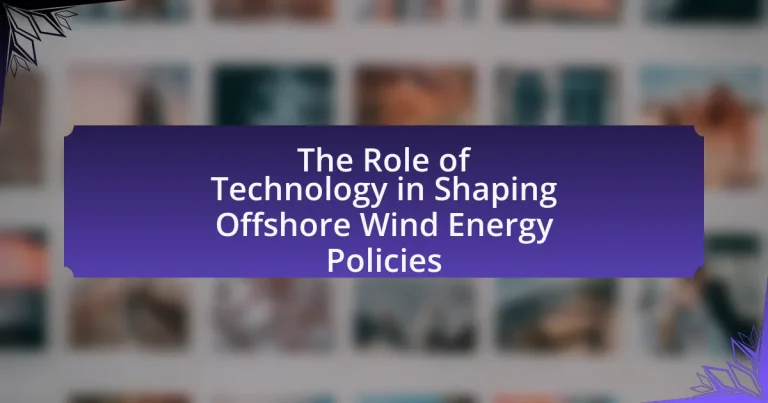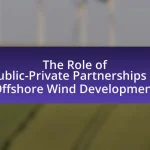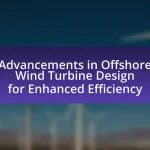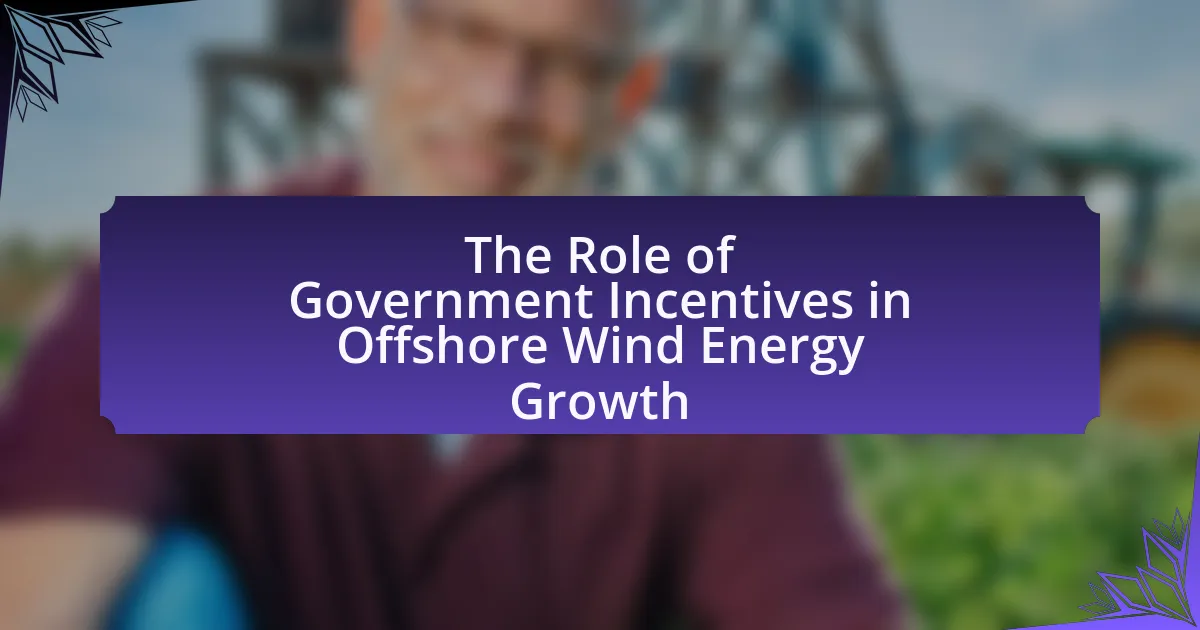The article examines the critical role of technology in shaping offshore wind energy policies, highlighting advancements in turbine efficiency, grid integration, and environmental monitoring. It discusses how innovations such as larger turbines and floating wind farms have reduced costs and increased energy output, prompting supportive policy frameworks. Additionally, the article explores the impact of digital technologies and data analytics on regulatory processes and decision-making, while addressing challenges such as integration with existing energy systems and financial barriers. Key technologies influencing policy development, including energy storage solutions and remote monitoring, are also analyzed, emphasizing their significance in promoting sustainable offshore wind energy initiatives.
What is the Role of Technology in Shaping Offshore Wind Energy Policies?
Technology plays a crucial role in shaping offshore wind energy policies by enabling advancements in turbine efficiency, grid integration, and environmental monitoring. These technological innovations lead to more effective energy generation and management, influencing policy decisions aimed at increasing renewable energy adoption. For instance, the development of larger, more efficient turbines has significantly reduced the cost of offshore wind energy, prompting governments to implement supportive policies and incentives. Additionally, technologies such as predictive analytics and remote sensing enhance environmental assessments, ensuring compliance with regulations and fostering public acceptance. The integration of smart grid technologies further supports the seamless incorporation of offshore wind energy into existing energy systems, driving policy frameworks that prioritize renewable energy sources.
How has technology influenced the development of offshore wind energy policies?
Technology has significantly influenced the development of offshore wind energy policies by enabling advancements in turbine efficiency, grid integration, and environmental monitoring. These technological improvements have led to increased energy output and reduced costs, prompting policymakers to create supportive frameworks that encourage investment and development in offshore wind projects. For instance, the deployment of larger and more efficient turbines has resulted in a decrease in the levelized cost of energy (LCOE) for offshore wind, making it competitive with traditional energy sources. Additionally, innovations in data analytics and remote sensing technologies have enhanced the ability to assess environmental impacts, leading to more informed regulatory decisions. As a result, countries have adopted policies that facilitate the expansion of offshore wind farms, reflecting the direct impact of technology on energy policy formulation.
What technological advancements have been pivotal in offshore wind energy?
Technological advancements pivotal in offshore wind energy include larger turbine sizes, floating wind farms, and enhanced energy storage systems. Larger turbines, such as those exceeding 10 megawatts, increase energy capture and efficiency, enabling greater power generation from fewer units. Floating wind farms allow deployment in deeper waters where wind resources are stronger and more consistent, expanding the geographical potential for offshore wind energy. Enhanced energy storage systems, including advanced battery technologies, facilitate the integration of variable wind energy into the grid, ensuring reliability and stability. These advancements collectively contribute to the growth and viability of offshore wind energy as a significant renewable energy source.
How do these advancements impact policy formulation?
Advancements in technology significantly impact policy formulation for offshore wind energy by providing data-driven insights that inform decision-making. For instance, improved modeling and simulation tools enable policymakers to assess the environmental and economic implications of offshore wind projects more accurately. This leads to more effective regulations and incentives that promote sustainable energy development. Additionally, advancements in monitoring technologies enhance compliance and performance tracking, ensuring that policies are adaptive and responsive to real-time data. As a result, these technological improvements facilitate the creation of robust policies that align with both environmental goals and energy needs.
Why is technology essential for the growth of offshore wind energy?
Technology is essential for the growth of offshore wind energy because it enhances efficiency, reduces costs, and improves energy output. Advanced technologies, such as larger and more efficient turbines, enable the capture of more wind energy, leading to increased electricity generation. For instance, the deployment of 12 MW turbines has been shown to significantly boost energy production compared to older models. Additionally, innovations in floating wind farms allow for installation in deeper waters, expanding the potential sites for wind energy generation. According to the International Energy Agency, offshore wind capacity could reach 200 GW by 2030, largely driven by technological advancements. These developments not only make offshore wind energy more competitive with fossil fuels but also contribute to achieving global renewable energy targets.
What role does technology play in enhancing energy efficiency?
Technology plays a crucial role in enhancing energy efficiency by optimizing energy consumption and reducing waste. Advanced technologies such as smart grids, energy management systems, and IoT devices enable real-time monitoring and control of energy use, leading to significant reductions in energy consumption. For instance, smart meters allow consumers to track their energy usage patterns, which can lead to more informed decisions and lower energy bills. Additionally, innovations in renewable energy technologies, such as more efficient wind turbines and solar panels, contribute to higher energy output with less resource input. According to the International Energy Agency, implementing energy-efficient technologies could reduce global energy demand by up to 30% by 2040, demonstrating the substantial impact of technology on energy efficiency.
How does technology contribute to cost reduction in offshore wind projects?
Technology significantly contributes to cost reduction in offshore wind projects by enhancing efficiency and reducing operational expenses. Innovations such as larger turbine sizes, advanced materials, and improved installation techniques lead to higher energy output and lower costs per megawatt-hour. For instance, the deployment of turbines with capacities exceeding 10 megawatts has been shown to increase energy generation while decreasing the cost of energy by approximately 30% over the past decade. Additionally, digital technologies like predictive maintenance and remote monitoring optimize performance and minimize downtime, further driving down costs. According to the International Renewable Energy Agency, the global average cost of offshore wind energy has fallen by 48% since 2010, underscoring the impact of technological advancements in this sector.
What are the key technologies shaping offshore wind energy policies?
Key technologies shaping offshore wind energy policies include floating wind turbines, advanced turbine designs, and digital monitoring systems. Floating wind turbines enable deployment in deeper waters, expanding the potential for offshore wind farms. Advanced turbine designs, such as larger rotor diameters and higher efficiency generators, increase energy output and reduce costs. Digital monitoring systems utilize IoT and AI to optimize performance and maintenance, enhancing reliability and efficiency. These technologies collectively drive policy frameworks by demonstrating feasibility, reducing costs, and increasing energy production, which are critical for meeting renewable energy targets.
Which technologies are most influential in offshore wind energy?
The most influential technologies in offshore wind energy include turbine design, floating platforms, and energy storage systems. Turbine design advancements, such as larger rotor diameters and higher capacity factors, significantly enhance energy output and efficiency. Floating platforms enable wind farms to be installed in deeper waters, expanding the potential for offshore wind energy generation. Energy storage systems, including batteries and pumped hydro storage, are crucial for managing the intermittent nature of wind energy, ensuring a stable supply. These technologies collectively drive the growth and viability of offshore wind energy, as evidenced by the increasing capacity and number of offshore wind projects globally, which reached over 35 gigawatts in installed capacity by 2021.
What is the significance of turbine design and innovation?
Turbine design and innovation are crucial for enhancing the efficiency and effectiveness of energy generation from wind resources. Advanced turbine designs, such as larger rotor diameters and improved blade aerodynamics, significantly increase energy capture, allowing for greater electricity production from the same wind conditions. For instance, modern offshore wind turbines can reach capacities of up to 12 MW, compared to earlier models that typically produced around 2-3 MW. This increase in capacity directly contributes to the economic viability of offshore wind projects, making them more competitive with traditional energy sources. Furthermore, innovations in materials and technology, such as lighter and more durable composites, improve the longevity and reliability of turbines, reducing maintenance costs and downtime. These advancements not only support the growth of renewable energy but also align with global efforts to reduce carbon emissions and combat climate change.
How do energy storage solutions affect offshore wind energy policies?
Energy storage solutions significantly enhance offshore wind energy policies by enabling better integration of variable wind power into the energy grid. These solutions, such as batteries and pumped hydro storage, allow for the capture and storage of excess energy generated during peak wind conditions, which can then be released during low production periods. This capability supports grid stability and reliability, making offshore wind a more attractive option for policymakers. For instance, the integration of energy storage can lead to reduced curtailment of wind energy, thereby maximizing the utilization of renewable resources and aligning with climate goals. Studies indicate that regions implementing energy storage alongside offshore wind projects experience improved energy security and lower overall energy costs, reinforcing the importance of these technologies in shaping effective energy policies.
How do digital technologies impact offshore wind energy policy-making?
Digital technologies significantly enhance offshore wind energy policy-making by improving data collection, analysis, and stakeholder engagement. These technologies enable real-time monitoring of wind resources and environmental impacts, facilitating informed decision-making. For instance, advanced modeling software allows policymakers to simulate various scenarios, optimizing site selection and project design. Additionally, digital platforms foster collaboration among stakeholders, including government agencies, developers, and local communities, ensuring that diverse perspectives are considered in the policy formulation process. The integration of Geographic Information Systems (GIS) and big data analytics has been shown to streamline regulatory processes and improve transparency, ultimately leading to more effective and adaptive offshore wind energy policies.
What role does data analytics play in policy development?
Data analytics plays a crucial role in policy development by providing evidence-based insights that inform decision-making processes. Through the analysis of large datasets, policymakers can identify trends, assess the impact of existing policies, and forecast future outcomes. For instance, in the context of offshore wind energy policies, data analytics can evaluate environmental impacts, economic feasibility, and public sentiment, enabling more effective and targeted policy interventions. Studies have shown that data-driven approaches lead to improved policy outcomes, as evidenced by the increased efficiency and effectiveness of renewable energy initiatives in various regions.
How does remote monitoring technology influence regulatory frameworks?
Remote monitoring technology significantly influences regulatory frameworks by enabling real-time data collection and analysis, which enhances compliance and oversight in offshore wind energy operations. This technology allows regulators to monitor environmental impacts, operational efficiency, and safety standards more effectively, leading to more informed decision-making. For instance, the integration of remote sensing and data analytics in offshore wind projects has prompted regulatory bodies to adapt existing policies to incorporate data-driven approaches, ensuring that regulations are responsive to real-time conditions and risks. This shift is evidenced by the European Union’s adoption of the Marine Strategy Framework Directive, which emphasizes the use of monitoring technologies to achieve sustainable marine environments.
What challenges does technology face in shaping offshore wind energy policies?
Technology faces several challenges in shaping offshore wind energy policies, primarily including integration with existing energy systems, regulatory hurdles, and the need for substantial investment in infrastructure. The integration challenge arises from the variability of wind energy, which requires advanced grid management technologies to ensure reliability and stability in energy supply. Regulatory hurdles often stem from outdated policies that do not accommodate new technologies or the rapid pace of innovation in offshore wind. Additionally, significant financial investment is necessary to develop the required infrastructure, such as specialized vessels and installation equipment, which can deter stakeholders from pursuing offshore wind projects. These challenges hinder the effective implementation and expansion of offshore wind energy policies.
What are the barriers to technology adoption in offshore wind energy?
Barriers to technology adoption in offshore wind energy include high capital costs, regulatory challenges, and technological limitations. High capital costs deter investment, as offshore wind projects require significant upfront financial commitment, often exceeding billions of dollars. Regulatory challenges arise from complex permitting processes and inconsistent policies across regions, which can delay project timelines and increase uncertainty for investors. Additionally, technological limitations, such as the need for advanced materials and reliable energy storage solutions, hinder the efficiency and scalability of offshore wind systems. These factors collectively impede the widespread adoption of offshore wind technology, as evidenced by reports indicating that financial and regulatory uncertainties are among the top concerns for stakeholders in the industry.
How do regulatory challenges affect technological innovation?
Regulatory challenges hinder technological innovation by imposing constraints that can slow down development and deployment processes. For instance, stringent regulations may require extensive testing and compliance measures, which can delay the introduction of new technologies to the market. A study by the National Renewable Energy Laboratory found that regulatory barriers can increase project costs by up to 30%, thereby discouraging investment in innovative solutions. Additionally, unclear or inconsistent regulations can create uncertainty for companies, leading to reduced willingness to invest in research and development. This dynamic is particularly evident in the offshore wind energy sector, where regulatory frameworks significantly influence the pace of technological advancements.
What financial obstacles hinder technology implementation?
Financial obstacles that hinder technology implementation include high initial capital costs, ongoing operational expenses, and limited access to funding. High initial capital costs are particularly significant in offshore wind energy projects, where investments can reach billions of dollars for infrastructure and technology development. Ongoing operational expenses, such as maintenance and staffing, further strain financial resources. Limited access to funding arises from stringent lending criteria and the perceived risks associated with new technologies, which can deter investors. According to the International Renewable Energy Agency, the average cost of offshore wind projects can be around $4,000 to $6,000 per installed kilowatt, highlighting the substantial financial barriers that must be overcome for successful technology implementation.
How can technology be leveraged to overcome these challenges?
Technology can be leveraged to overcome challenges in offshore wind energy policies by utilizing advanced data analytics and modeling tools to optimize site selection and resource assessment. These tools enable stakeholders to analyze wind patterns, environmental impacts, and logistical considerations more effectively, leading to informed decision-making. For instance, the use of Geographic Information Systems (GIS) allows for precise mapping of potential sites, while predictive modeling can forecast energy output and assess the feasibility of projects. Additionally, innovations in turbine design and materials enhance efficiency and reduce costs, making offshore wind energy more competitive. According to the International Renewable Energy Agency, advancements in technology have led to a 50% reduction in the cost of offshore wind energy since 2010, demonstrating the significant impact of technology on overcoming economic and operational challenges in this sector.
What strategies can be employed to enhance technology integration?
To enhance technology integration in offshore wind energy policies, stakeholders can employ strategies such as fostering collaboration among industry players, investing in research and development, and implementing standardized protocols. Collaboration among government agencies, private companies, and research institutions can lead to shared knowledge and resources, which is essential for addressing complex challenges in technology integration. Investment in research and development is crucial, as it drives innovation and the adoption of advanced technologies, evidenced by the increase in efficiency and cost-effectiveness of offshore wind projects in recent years. Standardized protocols facilitate smoother integration by ensuring compatibility and interoperability among different technologies, which has been shown to reduce operational risks and improve project outcomes in the offshore wind sector.
How can collaboration between stakeholders improve technology adoption?
Collaboration between stakeholders can significantly improve technology adoption by fostering shared knowledge, aligning goals, and enhancing resource allocation. When various stakeholders, such as government agencies, private companies, and community organizations, work together, they can identify common objectives and address barriers to technology implementation. For instance, a study by the International Renewable Energy Agency (IRENA) highlights that collaborative frameworks in offshore wind projects lead to increased investment and faster deployment of technologies. This synergy not only accelerates the adoption process but also ensures that the technology meets the needs of all parties involved, ultimately resulting in more effective and sustainable energy policies.
What best practices should be followed for effective technology integration in offshore wind energy policies?
Effective technology integration in offshore wind energy policies requires a multi-faceted approach that includes stakeholder engagement, regulatory frameworks, and continuous innovation. Engaging stakeholders, including local communities, industry experts, and policymakers, ensures that diverse perspectives are considered, leading to more comprehensive and accepted policies. Establishing clear regulatory frameworks facilitates the integration of new technologies by providing guidelines that promote safety, environmental protection, and economic viability. Continuous innovation, supported by research and development investments, is essential for adapting to evolving technologies and improving efficiency. For instance, the International Renewable Energy Agency reported that advancements in turbine technology have significantly reduced costs and increased energy output, demonstrating the importance of integrating cutting-edge solutions into policy frameworks.




